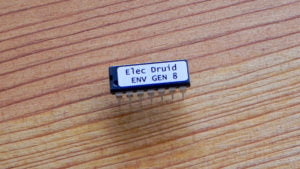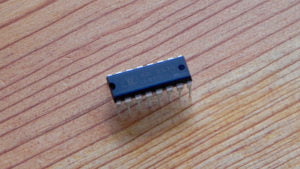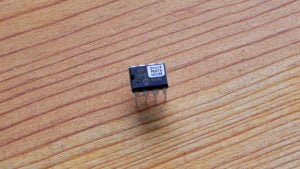Description
The ONESHOT chip is a One-Shot Event Generator. It creates interesting unipolar modulation waveforms made from a single ”ping”. You can alter the shape and speed of the ping, and also add decaying echos to it, with separate Delay and Repeats controls. This lets you easily generate interesting and unusual one-off modulation waveforms. It makes things that sounds like a ball bouncing on the floor, or a single hit with echoes, or a stick being dragged across a washboard.
As such, it exists somewhere in the area between an envelope generator and an LFO.
Download the Electric Druid ONESHOT Event Generator Datasheet
The datasheet includes the pinout diagram and application circuit.
Supply problems
We can’t get programmed, labelled chips at the moment, but we’ve got some blank ones and programmed them up. They’re functionally identical, but slightly less easy to identify on your bench!






Christophe (verified owner) –
Hi! Is there a way to replace the wave pot by a rotary switch ? Thanks
Tom Wiltshire –
Yes, there is! It’s detailed in the TapLFO datasheet (Pg9) but exactly the same method works for the OneShot chip, the StompLFO, or the VCLFO:
https://electricdruid.net/datasheets/TAPLFO3Datasheet.pdf
Christophe (verified owner) –
Cool! Thanks very much !
Andrew McLoud –
I became a big fan of that chip!
The final filtering stage in the schematic didn´t went out for me, so i ignored it …
Now it does the job in my eurorack.
I´d like to see more of these super easy to use 5V chips!
Tom Wiltshire –
The passive filter in the datasheet isn’t buffered in any way, so it won’t feed a low impedance. For some uses an active filter would be better. I should draw a Eurorack schematic for this thing…
The StompLFO is a similar design (this chip was based on it) and provides eight waveforms including two random waves. Check it out!
Jaga –
That’s pretty interesting chip. Just wondering, if there’s an easy way to use rotary encoder for Repeats CV input? It might be cool to use 36 detent rotary encoder for this.
Tom Wiltshire –
It’d be possible, but there’s not “an easy way”. The quadrature output from a rotary encoder is a long way from what the Repeats CV input is expecting, so you’d need some intermediate interface circuit to get from one to the other.
A pot-with-detents would get you closer more easily, but the chip wasn’t designed with that in mind and the Repeats CV response isn’t fully linear (it’s linear at the low end to allow you to select a specific number of repeats, but above about 16 or so, it becomes curved to increase the range, at the cost of making it harder to select a specific number). Anyway, I’ve never seen a 36-detent pot! The only commonly available ones are 11-detent. I once asked Alpha Taiwan about an 8-detent version, and they told me it probably wasn’t worth the tooling fee unless I needed 50K units a year or so! So it could be done, but you’ll need to buy a few…
Ben (verified owner) –
Great chip! Finally got around to building my module with it. I added voltage control over the repeat amount and rate by copying the voltage control circuit from the ENVGEN modular schematic. Works a treat. Also used added an extra op amp to buffer the output. I am now thinking that I’ll swap the voltage control from the repeat amount to the delay input. I guess you could add voltage control to all the inputs but I’m finding that I’m not really using the voltage control on the repeats and swapping means I don’t have to redo the front panel to add more pots and jacks. I reckon having voltage control over both the delay and the rate offers more interesting possibilities for modulating rhythm which is more in tune with my approach to synthesis at the moment. One final thought on patching; the module really shines when you have some kind of CV mixer in your setup. My go to patch so far is mixing the ONESHOT cv with a dash of the envelope signal, a splash of smooth random voltage from the STOMP LFO, and a -5V offset voltage. I do this because I’m sending the that mix of CVs into the filter of two separate synth voices. This means the knob controlling the -5V offset becomes a master knob that is similar to the cutoff of the filter but is now controlling both synths at the same time.